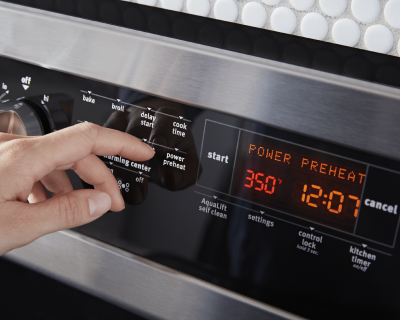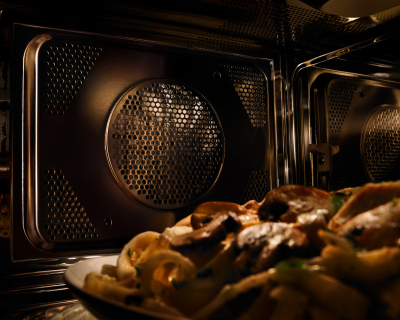
CONVECTION OVEN VS. MICROWAVE
Preparing meals at home can be a rewarding experience for you and your family. However, it can also be time-consuming and challenging, especially if you don't have the right appliances. Two common kitchen appliances are convection ovens and microwaves, each with its own unique set of benefits. Use this article to explore the differences between convection ovens and microwaves to help you choose the right appliance for your cooking needs.
WHAT’S THE DIFFERENCE BETWEEN A MICROWAVE AND CONVECTION OVEN?
When it comes to choosing between a microwave and a convection oven, there are a few key differences to consider. The main differences lie in capacity, heating methods, preheating options and cooking capabilities. When analyzing convection ovens vs microwaves, it's important to consider the following factors:

CAPACITY
One of the main differences between microwaves and convection ovens is their size and capacity. Microwaves are generally compact and available in various sizes, from countertop models to over-the-range models. Convection ovens come in a range of sizes, from compact countertop models to the traditional larger models able to accommodate multiple dishes at once.
Your cooking needs and space availability should be considered when deciding between a microwave and convection oven. You should also ensure, if choosing a full-size convection oven, that the appliance you pick fits the dimensions of your stove or built-in oven space.

HEATING METHODS
The heating methods for a convection oven and a microwave are vastly different. Microwaves use electromagnetic waves to heat food, while convection ovens use a fan and heating element to circulate hot air around the oven cavity. Microwaves offer different power levels and settings to help cook or reheat food, while convection ovens have the ability to bake, roast and broil food with the option of convection cooking for fast and even cooking across multiple racks.

PREHEATING OPTIONS
Before you can bake, roast or broil in a convection oven, you have to preheat the oven’s interior. Preheating a convection oven allows you to select your cooking temperature and allow the oven to reach that temperature before you begin cooking. Microwaves don’t require preheating before use, and cooking temperatures are determined by the setting and power level you select.

COOKING CAPABILITIES
Microwaves and convection ovens both have unique cooking capabilities. Convection ovens provide a wide range of cooking options, including baking, roasting, broiling and grilling to help you prepare large portions or multiple dishes at once. Select models also offer additional cooking options, such as dehydrating and air frying, depending on the model. Microwaves are ideal for reheating smaller meals or quickly cooking popcorn, mug-cake and frozen meals.

POWER SOURCE
One key difference between convection ovens and microwaves is their power source. While both appliances require electricity to function, a gas convection oven can use gas as a fuel source to heat food and microwaves rely entirely on electricity. This is an important factor to consider when choosing between the two appliances, especially if you have a gas hookup in your kitchen.


CAN A CONVECTION OVEN REPLACE A MICROWAVE?
While a convection oven can supplement a microwave for many cooking tasks, it cannot completely replace it. Microwaves typically offer quick and easy reheating and cooking of certain dishes that cannot be replicated in a convection oven.
However, a convection oven features a wide range of cooking capabilities, including baking, roasting, broiling and grilling, making it a versatile appliance to have in the kitchen.
WHICH IS BETTER: A MICROWAVE OR A CONVECTION OVEN?
The answer depends on your cooking needs and preferences. If you frequently cook small, quick dishes or have limited space in your kitchen, a microwave may be the better choice. Microwaves are generally smaller and less expensive, making them a practical option for those with smaller kitchens or tighter budgets.
However, if you want more cooking capabilities, larger cooking capacity and have the space for it, a convection oven may be the better option. Convection ovens use a fan to circulate hot air, allowing for more even cooking across multiple racks. They also have the ability to toast, roast, broil and bake, making them a more versatile choice. Also, convection ovens have the ability to cook at high temperatures, which is ideal for baking and cooking certain dishes.
Itʼs important to consider factors such as size, heating methods, preheating options and cooking capabilities when deciding.
EXPLORE MAYTAG® CONVECTION OVENS AND MICROWAVES
Maytag brand offers a variety of ovens and microwaves to meet your cooking needs. From compact countertop microwaves to large double wall ovens, there are sizes to fit any kitchen. Whether you prioritize speed, space, or size, Maytag brand has an option for you. With features on select models such as EvenAir™ True Convection, Power Preheat and Sensor Cooking, Maytag brand appliances offer cooking capabilities you can depend on.
Learn More About Ovens and Microwaves from Maytag BRAND
-
 How Does a Microwave Work? Discover how microwaves work to quickly heat your food, learn the benefits of microwave cooking, and explore the various settings available to cook or defrost your meals.
How Does a Microwave Work? Discover how microwaves work to quickly heat your food, learn the benefits of microwave cooking, and explore the various settings available to cook or defrost your meals. -
 What is a Convection Microwave? Did you know you could bake, broil and roast in your microwave? Explore the benefits of a convection microwave and decide whether it’s right for your home.
What is a Convection Microwave? Did you know you could bake, broil and roast in your microwave? Explore the benefits of a convection microwave and decide whether it’s right for your home. -
 What Is a Convection Oven? Learn what a convection oven is and compare the benefits of convection vs. conventional ovens. Our guide will help you find the right oven for your home.
What Is a Convection Oven? Learn what a convection oven is and compare the benefits of convection vs. conventional ovens. Our guide will help you find the right oven for your home.

